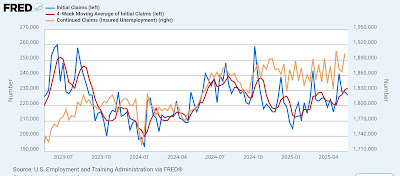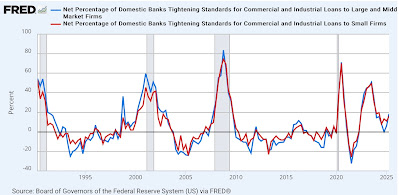- by New Deal democrat
Today let me address the GOP bust-out budget bill, and how that plays into Moody’s downgrade of US debt last week.
And the bottom line is that, it is bad. The rubber is starting to hit the road.
Let me start out with the below graph from the CBO of the past and future projection of the US debt to GDP ratio:
As you can see, until 1980 during periods of peace and prosperity, the US had generally paid down debt as a share of GDP. Debt was incurred during WW1, and paid down during the 1920s. It increased as a result of the Great Depression and WW2, but in the prosperous post-war period was paid down again.
This dynamic changed beginning with Reagan’s “supply side” budget cuts of the early 1980s. Only during Clinton’s Presidency during the prosperous 1990s was debt generally paid down again as a share of GDP. But since the election of George W. Bush a quarter century ago, even during periods of peace and prosperity, the debt shot up.
Now with the latest GOP budget bill, even without any crises, just with continued peace and prosperity, the debt is primed to rise to nearly 250% of GDP in the next several decades!
The Bond Market has noticed. And it is not amused.
Just for example, here is a graph I pulled this morning, showing that yesterday’s 30 year bond auction resulted in yields of 4.96%, close to the highest in almost 20 years:
Let me step back now and show you a graph of 10 year Treasury yields since 1981:
These were in a long term downtrend until the 2010s. That probably would have been their low except for the brief COVID emergency of 2020. But since then the downtrend has clearly been broken.
And once that kind of trend breaks, it very much tends to stay broken.
For reasons probably having to do with living market participants not remembering an event or era, bond yields tend to move in arcs more or less equivalent to one human lifespan (or “saeculum,” if you want the fancy word).
Here is the last full roughly 60 year cycle, from 1920 to 1981:
Yields fell until after WW2, and then gradually rose throughout the 1950s through 1970s.
And here is the previous cycle, from roughly 1860 to 1920, using railroad bonds:
With one exception, yields generally trended downward for about 40 years to 1900, and then gradually rose again for the next 20.
Today, nobody under the age of 50 remembers the stagflationary 1970s. It has faded from most living memory. Instead, the lesson for the past 40 years has been Dick Cheney’s infamous statement that “Reagan proved that deficits don’t matter.”
Well, they might have started to matter to foreign buyers of US Treasuries, which are now at 20 year lows as a share of total investors:
Here is a closeup on the last five years:
If foreign buyers of your country’s debt are getting squeamish, you either need to pay higher yields to attract interest, or you need to finance the debt with domestic buyers.
But if debt is growing faster than GDP, then ipso facto there is less new domestic wealth to buy those increased number of bonds.
One other way to attract foreign investment is if your currrency is appreciating relative to theirs (because the improved exchange rate over time more than makes up for the lower yield). And in the past 30 years, the trade weighted US$ has generally held its value, and in fact it had been improving since the Great Recession, including the post-COVID expansion:
But what happens if the US$ starts to lose its luster? Two days ago the
Peoples Bank of China announced that it was going to begin to encourage other countries to use the Yuan as a global currency, and obvious challenge to the US$.
If the US$ starts to trend lower agains the Yuan, another reason for foreigners to tolerate raging US deficits is vaporized.
In other words, the currency and bond market fundamentals suggest that the only way for the US to sustain these never-ending deficits is to pay increasingly higher interest rates.
Which means that domestic borrowers for things like mortgages, vehicles, and plants and equipment will have to pay higher rates.
All for the second tax bill in a row from the GOP that almost exclusively helps the rich:
And indeed, this bill *penalizes* the lower 40% of American taxpayers.
As I said above, the Bond Market is Not Amused.




























